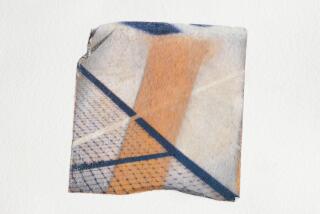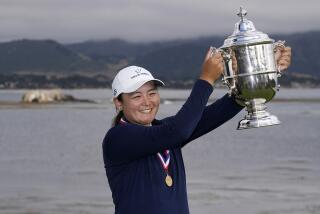TENNIS : Lori McNeil Back on the Right Track
Just 3 1/2 years ago, 23-year-old Lori McNeil looked like a sure bet for greatness when she defeated Chris Evert at the U.S. Open, then forced eventual champion Steffi Graf to three sets in the semifinals before losing, 4-6, 6-2, 6-4.
But stardom turned out to be an elusive target for McNeil, whose tennis career took an altogether different tack.
Last year, she played 20 tournaments, losing her first match in 11 of them. She fired longtime coach John Wilkerson, worked part time with John Lloyd, signed Bruce Foxworth as a part-time coach, hired Willis Thomas full time, fired Thomas, then rehired Wilkerson.
Said Wilkerson: “She didn’t have no direction at all.”
Wilkerson, who coached McNeil since she was 11, learned he was no longer needed from Ruth Givens, the mother of McNeil’s friend, Robin Givens, who called him to say he was fired.
“The bad thing was, we never talked. . . . I never heard from Lori,” Wilkerson said.
That was in April, 1988. McNeil, who rose to her best ranking, No. 9, in September 1988, is working her way back at No. 31. Late one night earlier this year, she decided that Wilkerson needed to receive another telephone call. This time, McNeil made the call herself. Tearfully, she asked Wilkerson to help her out again.
“She was kind of out of it,” Wilkerson said. “She said she had made a mistake. She said I knew her game better than anybody. The others didn’t. She came to them with problems, and they didn’t know what the heck she was talking about. (With) Lori, they look at all that talent, they take it for granted that everything is there.”
Obviously, everything wasn’t, although her physical talent is undeniable. McNeil’s speed is unsurpassed in women’s tennis, and her quickness augments a glowing serve-and-volley game built on power and angles. But as McNeil and others have proved, there is more to tennis than shotmaking.
“I kind of lost a little bit of confidence,” McNeil said. “But now I feel good about myself. A lot has to do with getting back with John. I haven’t given up on myself. Maybe people around me have, but I still feel I have time. I know I haven’t reached my full potential. I’m still here.”
McNeil dropped in class in February to play a small tournament at Denver and won it, defeating Manon Bollegraf in the final. It was Wilkerson’s first tournament as McNeil’s coach the second time around.
Wilkerson, 51, who discovered pre-teens McNeil and Zina Garrison playing on the public courts of Houston, said his primary focus is the “mental part” of McNeil.
“A lot of things happened to Lori that she didn’t understand,” Wilkerson said. “I think she can be easily influenced. She was always told what to do. She never had a chance to really grow up. She’s lost confidence in herself. She’s scared to do anything. I’m teaching her how to be nice to herself: Don’t be so negative.
“There’s no doubt it’s up to Lori,” he said. “I’m dealing with her tennis past. I think she’ll come around and I think she’ll do well at Wimbledon. I’ll tell you, you won’t find (a) better person than Lori. My job is to get her back on track and feeling good about herself. That’s what was gone.”
Doubles trouble: Identical 12-year-old twins Mike and Bob Bryan of Camarillo, each 5-feet-3 and 80 pounds, reached the quarterfinals of the Easter Bowl tournament at Miami last week before losing, but they should look on the bright side. At least they didn’t have to default.
Mike, a right-hander, and Bob, a left-hander, refuse to play each other in finals of junior tournaments such as the Easter Bowl, where they were both seeded in the boys’ 14 age group. At last count, one of the Bryans, sons of Cabrillo Racket Club owners Kathy and Wayne Bryan, has defaulted 30 times instead of playing his brother in a final.
“You can’t be No. 2 in the world if you’re No. 2 in your own bedroom,” said Mike, the eldest by two minutes.
Today’s question: Who is No. 4 in the ATP rankings?
Hall monitor: Last week’s selection of Romanian Ilie Nastase and Argentine Guillermo Vilas to enter the International Tennis Hall of Fame may never have happened if someone besides the media did the choosing.
Certainly both Nastase and Vilas deserve the honor, as does Ashley Cooper of Australia, also chosen to enter the hall in July, but both Nastase and Vilas clearly experienced a sometimes strained relationship with the tennis Establishment, which must go along with the media committee’s decision.
Nastase, 44, was the original bad boy of tennis, before there was a Jimmy Connors or a John McEnroe. Regarded as one of the game’s greatest shotmakers, Nastase was held in similar esteem as the prime umpire-baiter, linesman-intimidator, most off-color and cantankerous player of his generation or any that has followed.
“I feel I had to play my way, “ Nastase told the Associated Press after learning of his selection to the Hall of Fame. “I feel like an old man. I am lucky, I guess.”
Nastase was ranked in the top 10 from 1969 to 1977 and was No. 1 in 1973. He won 57 singles titles, including the 1972 U.S. Open and the ’73 French Open.
Vilas, 38, who won the French Open and U.S. Open singles titles in 1977 and the Australian Open singles titles in ’78 and ‘79, may be remembered equally for his landmark suspension and fine after he was accused of violating international tennis rules for accepting appearance money. Such practices, which were once forbidden, are now legal and commonplace on the ATP Tour.
All three players will be enshrined during the Hall of Fame tournament July 8-14 at Newport, R.I., where Miller has been brought on as title sponsor, and proceeds from the event go to the Hall of Fame, a nonprofit organization dedicated to preserving tennis history.
The Miller Hall of Fame event is the only remaining men’s professional grass court tournament in the United States.
Age-old problem?: Eleanor Keeling, 60, wants to play tennis for Cal State Sacramento, but the college and the NCAA refuse to let her, citing a rule that because she is over 20, she loses a year of eligibility for every year she has played competitively.
A federal judge in Sacramento recently refused to grant a preliminary injunction to force Cal State Sacramento to allow Keeling on the women’s team.
Keeling accused the university and the NCAA of age discrimination. Keeling, a junior majoring in physical education, was ineligible under an NCAA rule, the university said. Keeling has played in city-sponsored tournaments for the past 20 years.
“Mrs. Keeling is not being disqualified because she is 60 years old,” NCAA lawyer Craig Stewart told the Associated Press. Stewart said Keeling was disqualified because her experience gave her an unfair advantage over younger student-athletes.
Answer: Guy Forget of France, trailing only No. 1 Stefan Edberg, No. 2 Boris Becker and No. 3 Ivan Lendl.
Tennis Notes
Dade County has hired an architectural firm to design a permanent $16.5-million tennis stadium for the International Players Championships at Key Biscayne, Fla. The stadium will include 7,500 permanent seats and 6,500 temporary ones to stage the 10-day tournament for men and women, which has had a temporary stadium since it moved to that city in 1987. The new stadium is expected to be completed in early 1993.
The Southern California Senior Sectional Championships will be held April 5-14 at the Racket Centre of Universal City in North Hollywood. Some of the top men’s players competing in different age groups are Larry Barnett and Tony Smith of Los Angeles in the 30; Bob Chappell of Woodland Hills and Rollin Stone of Culver City in the 35; Steve Messmer and Art Santilli of Camarillo in the 40; Jack Metalsky of Manhattan Beach and Bob Erickson of Anaheim in the 50; Chuck Nelson of Santa Monica and Tom Springer of Canoga Park in the 55; Mel Lewis of Inglewood and John Bennett of Sherman Oaks in the 60; Pete Welsh of Claremont and Jack Simpson of Van Nuys in the 65; Glenn Turnbull of Corona del Mar and Bill Leveille of Long Beach in the 70; Dan Walker of South Gate and Jack Behr of Santa Barbara in the 75, and Bill Conel of Oceanside and Ron Brandon of Anaheim in the 85. Brandon, 87, is the tournament’s oldest entry.
In the women’s division, the top players entered are Linda Higgins of Yorba Linda and Lajla Feichter of Midway City in the 30; Kandy Chain of Los Angeles and Melanie Wheatley of Long Beach in the 35; Debby McCormick of Huntington Bech and Dee Williams-Horne of Pasadena in the 40; Alice Middleton of Santa Monica and Joan Allison of Newport Beach in the 45; Sinclair Bill of Carpinteria and Audrey Folden of Claremont in the 50; Betsy Roberti of Santa Monica and Louella Wohlgemuth of Carpinteria in the 55; Lois Horton of Los Angeles and Maria Denker of Studio City in the 60; Dodo Cheney of Santa Monica and Piyachart Hussey of Laguna Hills in the 65; Pat Yeomans of Los Angeles and Eleanor Harbula of Sylmar in the 70, and Rosemond Hyde of El Centro and Jacqueline Piatgorsky of Los Angeles in the 75.
More to Read
Go beyond the scoreboard
Get the latest on L.A.'s teams in the daily Sports Report newsletter.
You may occasionally receive promotional content from the Los Angeles Times.










